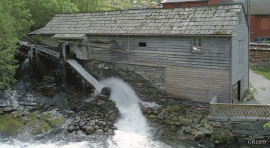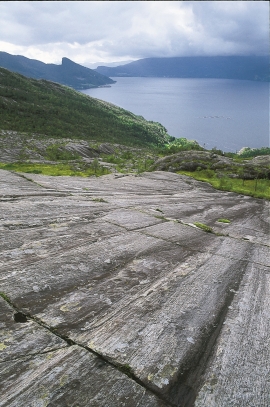- Remove Vernacular arts filter Vernacular arts
- Remove Defense filter Defense
- Remove Hardanger og Voss filter Hardanger og Voss
- Remove Museum filter Museum
- Remove Boat- and shipyards filter Boat- and shipyards
- Remove Thrust sheets filter Thrust sheets
- Remove Sawmills filter Sawmills
- Remove Nordhordland filter Nordhordland

Herand- Tveiti sawmill
Tveiti sawmill in Herand is probably the last water-powered sash-saw in the country that has been in regular operation up to our time. There has been a sash-saw here since the 1700s, and on the other side of the river there are remains of an even older saw.

Vinappen
Vinappen lies on a low hill to the very west on the island. Here you have an amazing panorama of the sea. Originally the area was grazing land for cattle, but this changed when the Germans occupied the island. Just before WWII there was a small bearing station, used by the Norwegian Coast Artillery in connection with exercises at sea.

Mollandseid
In Mollandsvågen, close by the river that runs from Mollandsvatnet (lake) into the fjord, are two water-powered circular saws and a mill. This small industrial centre has belonged to the farms Molland, Reknes and Duesund, which together own the rights to the waterfall

Håøy
Håøy lies centrally in one of the main shipping lanes going into Bergen --- with Håyøsund on the south side facing Meland, and Hagelsundet facing Lindåslandet. Names like Nordfarskista and Nordfarsskorane explain things. The strategic position was important in Viking times and it has been important in our days too. The beacon on Håøy can have been built in the establishment of the coastal administration in Håkon the Good’s time, about 950 AD. The defence structure of which we say remains on Håøy Summit held a critical position during Norwegian neutrality during the First World War. The defence structure was taken down in 1957.

Valestrandsfossen- tanning industry
Valestrand became a centre for the tanning industry in Osterøy; one of the old crafts that has developed into a local industry with many places of work. From the 1870s ever more ventures were started. Many of the large sea houses we see today around the bay have been places for tanning and leather enterprises.

Berge
Down by the fjord on the farm Berge in Tørvikbygd, is Stekkavika – a sheltered eastward facing harbour, protected against the fjord by headlands and rocks, even manifest in the name. Here is also a comprehensive milieu of coastal industry, with boathouses and sea-sheds that belong to the farms Berge, Heradstveit and Halleråker. Belonging to the farm Berge there is also a mill-house, circular saw, workshop for sloop building, and – a little further up into the woods – the old water-powered sash-saw.


Tyssedal
Today Tyssedal appears like a classical industrial community, a picture of modern Norway from the turn of the former century until today. A/S Tyssefaldene was established in 1906, and on 1 May 1908 Tyssedal power station was put into operation. The work on the first stage of the facility was completed in a short time, with a work force of 500 men. They built water tunnels, regulation reservoirs, power station, penstocks, harbour, cableways, office buildings, houses and 6 km of power lines in the wild mountains above Odda to provide the new melting plant with power.

Huse
The farm Huse is situated on a broad terrace in the valley above the church and the commons ground in Kinsarvik. Huse is one of the largest farms in Kinsarvik. The house from the Middle Ages, still standing at Huse today, probably from the middle of 1200, is joined on to a house in the Swiss style from around 1890. This house, with a smoke-vent in the roof, bears witness of a grand old farm and of the chieftain’s power in early medieval times.

Hereiane
At Hereiane on warm summer days one you can walk barefoot up the hill from the fjord all the way up to 400 metres elevation. The naked, furrowed bedrock often causes travellers who see it from the north side of the fjord to wonder. Why does it look like this, and why is there so little that grows here? It is a long way to the heavy metal industry in Ålvik and Odda, and there hasn’t been a forest fire in modern times.


